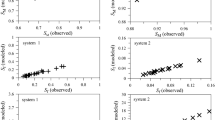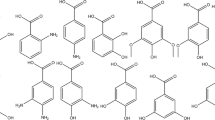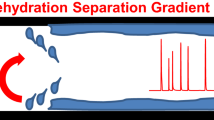Abstract
The selection of an optimal mobile phase pH under solvent gradient conditions is experimentally challenging. Although quaternary pumps are widely available, they are often used in binary mode to run simple solvent gradients with one pH-adjusted buffer at a time. A more effective use of quaternary pumps is to deliver two different aqueous buffer components (A and B) in a constant proportion to simulate a single, premixed buffer component, while simultaneously producing a solvent gradient by increasing the organic solvent component (S). This approach largely automates the pH optimization experiments. A more detailed investigation of pH effects becomes possible with less time and effort. Once a suitable pH has been identified, the same separation can be reproduced by a simpler binary gradient method which is more suitable for routine work. This study demonstrates the feasibility of this approach both theoretically and through actual examples.
Similar content being viewed by others
References
Horváth C, Melander W, Molnár I (1977) Anal Chem 49: 142–154
Otto M, Wegscheider W (1983) J Liq Chromatogr 6: 685–704
Kiel JS, Abramson RK, Morgan SL, Voris JV (1983) J Liq Chromatogr 6: 2761–2773
Rosés M, Bosch E (2002) J Chromatogr A 982: 1–30
Subirats X, Bosch E, Rosés M (2004) J Chromatogr A 1059: 33–42
Molnar I (2002) J Chromatogr A 965: 175–194
Haber P, Baczek T, Kaloszan R, Snyder LR, Dolan JW, Wehr CT (2000) J Chromatogr Sci 38: 386–392
Goldberg AP, Nowakowska E, Antle PE, Snyder LR (1984) J Chromatogr 316: 241–260
Kiel JS, Morgan SL, Abramson RK (1985) J Chromatogr 320: 313–323
Kaliszan R, Wiczling P, Markuszewski MJ (2004) Anal Chem 76: 749–760
Bartha A, Vigh G (1989) J Chromatogr 485: 383–401
Bilke HW, Molnar I, Gernet C (1996) J Chromatogr A 729:189–195
Espinosa S, Bosch E, Rosés M, Valkó K (2002) J Chromatogr A 954: 77–87
Hewitt EF, Lukulay P, Galushko S (2006) J Chromatogr A 1107:79–87
Snyder LR, Kirkland JJ, Glajch JL (1997) Practical HPLC Method Development, 2nd ed., Wiley, New York, p. 300
Snyder LR, Kirkland JJ, Glajch JL (1997) Practical HPLC Method Development, 2nd ed., Wiley, New York, pp. 311, 701–702
Snyder LR, Kirkland JJ, Glajch JL (1997) Practical HPLC Method Development, 2nd ed., Wiley, New York, p. 473
Budavari S, O'Neil MJ, Smith A, Heckelman PE (1989) The Merck Index, 11th ed., Merck & Co., Inc., Rahway, NJ, pp.49 & 4159.
Author information
Authors and Affiliations
Corresponding author
Rights and permissions
About this article
Cite this article
Loeser, E., Babiak, S., Zhu, P. et al. Automation of pH Optimization Experiments During LC Development. Chroma 63, 345–351 (2006). https://doi.org/10.1365/s10337-006-0759-0
Received:
Revised:
Accepted:
Published:
Issue Date:
DOI: https://doi.org/10.1365/s10337-006-0759-0




